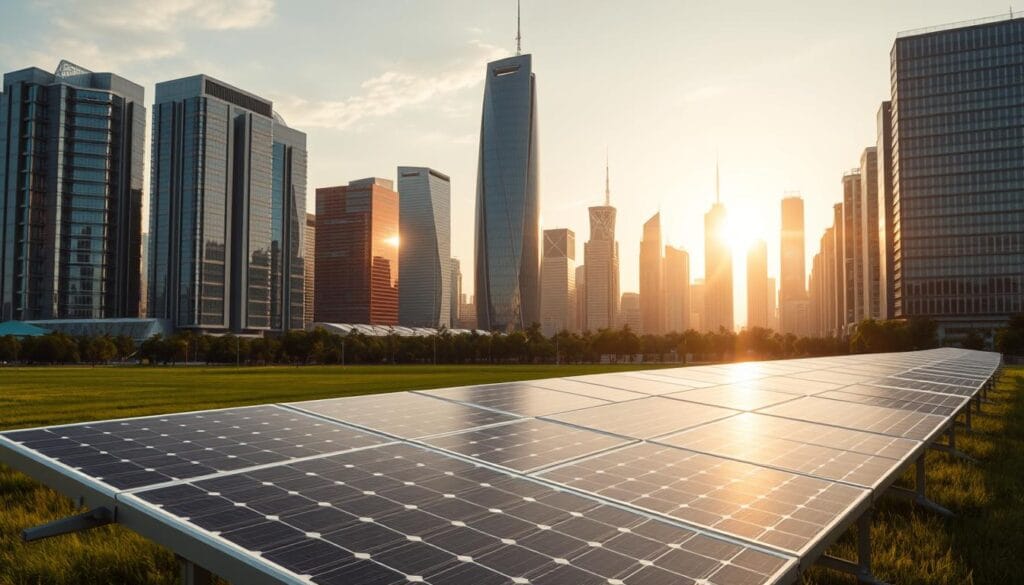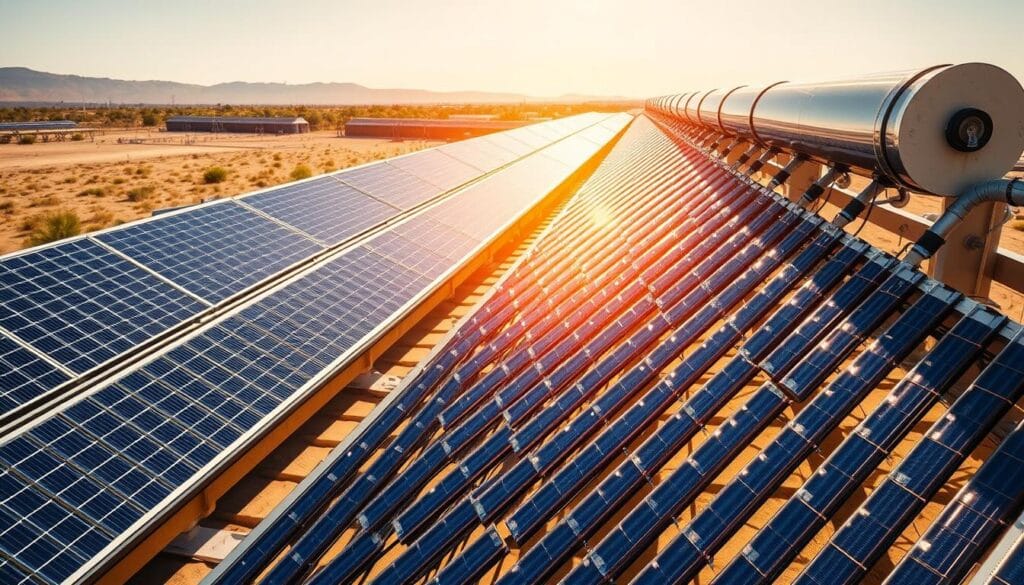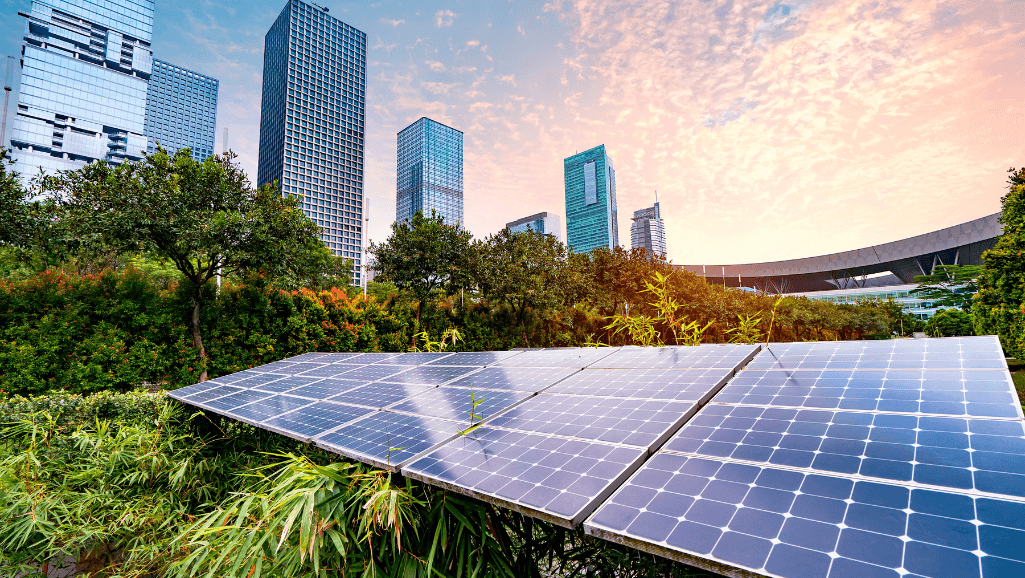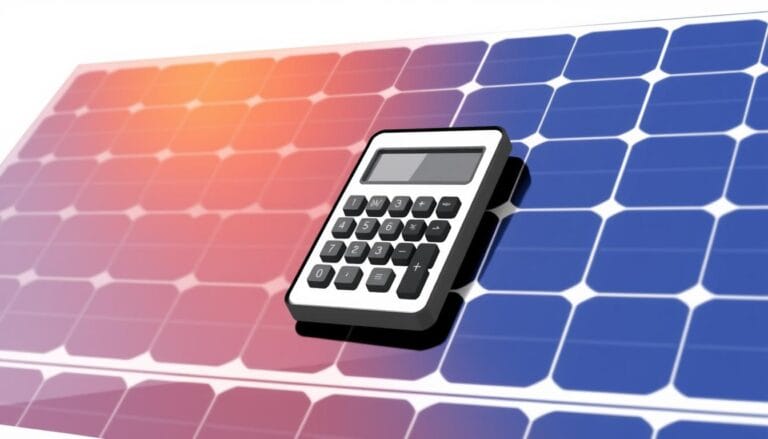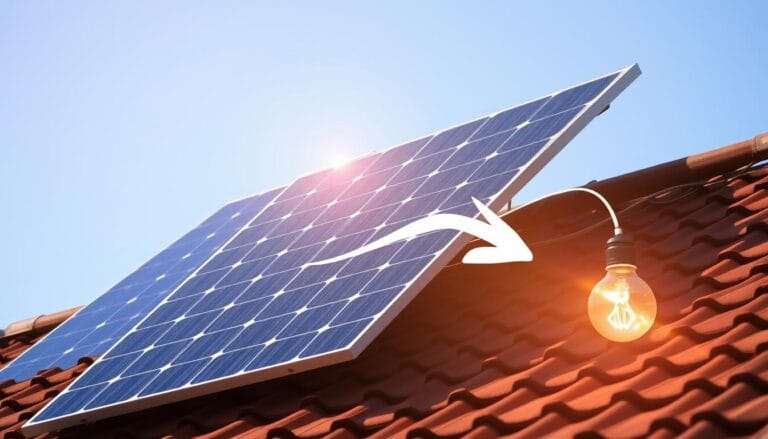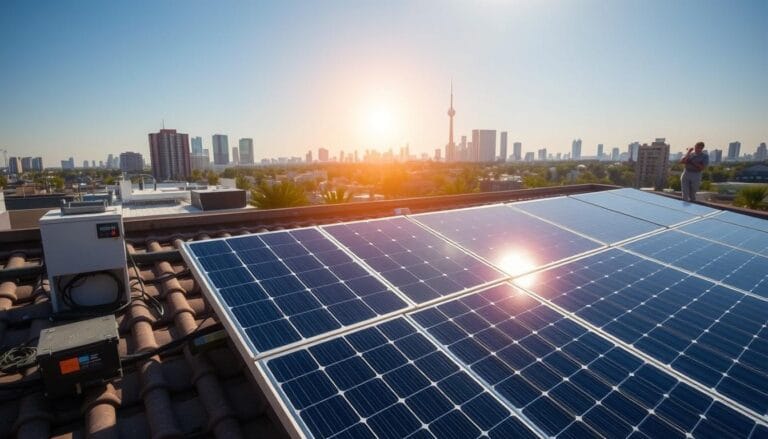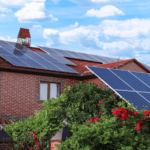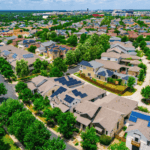The Earth gets a huge 174 petawatts of solar radiation every year. About 70% of this is absorbed and turned into 3,850,000 exajoules of solar energy. This has led to many solar technologies, each using the sun’s power in its own way.
Photovoltaic solar cells turn sunlight into electricity directly. Concentrated solar power systems use the sun’s heat for industrial processes. Solar thermal energy captures the sun’s heat for heating water and spaces. In India, solar water heating systems are popular for their ease and cost-effectiveness.
Building-integrated photovoltaics (BIPV) blend solar cells into building designs. This increases energy efficiency and makes buildings look better. Projects like the Copenhagen International School show how BIPV can be both cost-effective and stylish
Passive solar energy uses natural light and heat through building design. It uses smart insulation and thermal mass to cut down on heating and cooling needs. This makes buildings more energy-efficient and sustainable.
As solar technology gets better, we see new ideas like floating photovoltaics and solar panels in agriculture. The future of solar energy looks very promising.
Key Takeaways
Types of Solar Technologies.
- Solar energy technologies use the sun’s power in many ways, like photovoltaic cells, concentrated solar power, and solar thermal energy.
- India is a leader in solar energy, growing its solar capacity and using its sunny climate to its advantage.
- Solar thermal energy and solar water heating are popular in India for their cost and ability to provide hot water.
- Building-integrated photovoltaics (BIPV) blend solar cells into buildings, improving energy efficiency and looks.
- Passive solar design uses smart insulation and thermal mass to reduce heating and cooling needs, promoting sustainability.
The Potential of Solar Energy in Renewable Solutions
Solar energy is changing the game in renewable energy, offering a big chance to meet our energy needs and fight climate change. The Earth gets a huge 174 petawatts of solar radiation, with 30% bouncing back into space. This means our planet absorbs 3,850,000 exajoules of solar energy every year. This shows how important solar power is for a sustainable future.
Understanding Solar Power’s Enormous Potential
Solar energy’s potential is huge, with just 90 minutes of sunlight enough to power the world for a year. Solar panel efficiency has jumped from about 10% to over 20% or even 25%. These improvements make solar power very cheap, especially in sunny places.
The Global Solar Energy Capacity
The world’s solar energy capacity is growing fast, thanks to the need for clean energy and cheaper solar tech. Studies say it will hit 748 GW by 2050. This growth is driven by more countries using solar power, seeing its economic and environmental benefits.
| Solar Technology | Efficiency | Applications |
|---|---|---|
| Photovoltaics (PV) | 20-25% | Electricity generation |
| Solar Heating and Cooling (SHC) | 60-75% | Water heating, space heating/cooling |
| Concentrated Solar Power (CSP) | Up to 80% | Large-scale electricity generation |
India’s Geographical Advantage in Solar Power
India is in a great spot for solar energy, thanks to its geography. It gets 4-7 kWh per square meter per day, covering most of the country. This has led to companies like Fenice Energy, which are leading in solar power solutions. India’s solar capacity is expected to be huge, at 748 GW by the National Institute of Solar Energy (NISE).
Solar energy is also a good option for off-grid systems, bringing power to remote areas. With the right support and policies, India can use its solar resources well. It could meet its energy needs and become a leader in renewable energy.
Photovoltaic Solar Energy: Leading the Way
Photovoltaic (PV) technology is at the forefront of solar energy. It uses the sun’s power to make clean, renewable electricity. PV solar energy is changing how we power our homes, businesses, and communities. By the end of 2020, the world had 710 GW of solar PV capacity, with 125 GW added that year.
The Science Behind Solar Cells
Solar cells are key to photovoltaic technology. They turn sunlight into electrical energy through the photoelectric effect. When sunlight hits a solar cell, it excites electrons, making them flow and create an electric current. This process is crucial for solar panel efficiency and has seen a lot of research.
Monocrystalline, Polycrystalline, and Thin-Film Panels
The solar market offers many options for different needs and budgets. Monocrystalline silicon panels are very efficient, sometimes up to 25% in tests. They are made from single silicon crystals, giving them a sleek look. Polycrystalline silicon panels are more affordable and versatile, chosen by many.
Thin-film solar panels are flexible and light, made from materials like cadmium telluride or copper indium gallium selenide. They have unique benefits for certain applications.
| Panel Type | Efficiency | Characteristics |
|---|---|---|
| Monocrystalline | Up to 25% | High efficiency, uniform appearance |
| Polycrystalline | Up to 20% | Cost-effective, versatile |
| Thin-Film | Up to 15% | Lightweight, flexible |
Versatility in Photovoltaic Installations
Photovoltaic solar energy is very versatile. Solar panels can go on rooftops, the ground, or even into building facades. This lets us use spaces like home roofs, commercial buildings, and parking garages. With better solar panel efficiency and lower prices, solar tech is getting more affordable and competitive with traditional energy.
Solar Thermal Energy: Harnessing the Sun’s Heat
Solar thermal energy uses the sun’s heat for efficient and green solutions. It’s used for solar water heating, space heating, and air conditioning. This technology turns solar radiation into heat, making it a sustainable choice compared to traditional energy sources.
Solar water heating is a key use of solar thermal energy. Solar thermal collectors turn sunlight into hot water for homes and businesses. An Intel report shows that solar quotes can cut electricity bills by 94%, showing solar energy’s big potential.
It’s also great for heating and cooling spaces. Passive solar heating uses building design to capture and store heat naturally. Active solar heating uses collectors on roofs to send heat to buildings through pipes or heat exchangers.
Big projects also use solar thermal energy. By focusing sunlight with mirrors, it can make electricity by turning liquid into steam to power turbines. The U.S. has big solar projects like:
- Solana Generating Station in Gila Bend, Arizona: a 296 MW, two-plant facility with energy storage that started operating in 2013
- Mojave Solar Project in Barstow, California: a 275 MW, two-plant facility that started operating in 2014
- Genesis Solar Energy Project in Blythe, California: a 250 MW, two-plant facility that started operating in 2013 and 2014
- Ivanpah Solar Power Facility in Ivanpah Dry Lake, California: with a combined net summer electric generation capacity of 393 MW, started operating in 2013
There are 11 CSP projects in the U.S. now, all over 100 megawatts big. They’re much bigger than what you’d find at home.
| Technology | Concentration Ratio | Heat Transfer Fluid |
|---|---|---|
| Linear Fresnel Reflectors | 30 times normal intensity | Water |
| Solar Power Towers | Up to 1,500 times | Water or Molten Nitrate Salt |
Solar thermal technology meets many energy needs, from electricity to heating water and warming buildings. As we move towards a greener future, solar thermal energy will be key in the renewable energy mix. It offers clean, efficient, and affordable solutions.
Concentrated Solar Power: Maximizing Efficiency
Concentrated Solar Power (CSP) technology uses the sun’s heat to make electricity. It focuses sunlight onto a small area with mirrors or lenses. This heat makes steam that turns turbines to create electricity. Concentrating solar power technology is special because it can store heat for later. This means it can make electricity even when it’s cloudy or at night.
How Concentrated Solar Power Works
There are four main types of CSP systems: parabolic trough, power tower, linear Fresnel, and dish/engine. Each type focuses sunlight differently but all aim to collect solar energy. The focused sunlight heats a fluid in a receiver. This fluid then drives a turbine or engine to make electricity. Many CSP plants also have systems to store heat, like molten salt tanks. This lets them keep generating power when it’s cloudy or at night.
Notable CSP Projects Worldwide
The United States has big CSP projects, with about 1,815 megawatts of capacity. Some big ones include:
- Ivanpah Solar Electric Generating System in California (392 MW)
- Mojave Solar One parabolic trough plant in California (280 MW)
- Solana parabolic trough plant in Arizona (250 MW)
- Genesis Solar in Blythe, California (250 MW)
- Crescent Dunes in Nevada (110 MW with 10 hours of storage)
The Ouarzazate Solar Power Station in Morocco is the biggest CSP plant, with 510 megawatts over 3,500 soccer fields.
Advancements in Solar Efficiency and Storage
Research and development are making CSP better and cheaper. CSP systems can turn solar energy into electricity with 7 to 25 percent efficiency, similar to many solar panels. Improvements in solar energy storage, like molten salt tanks, make CSP plants more reliable and flexible.
| Technology | Efficiency Range |
|---|---|
| Concentrated Solar Power (CSP) | 7-25% |
| Photovoltaic Solar Panels | 14-23% |
| Wind Turbines | Up to 59% |
| Hydropower Systems | Up to 90% |
As CSP technology gets better, it will play a big role in our move to a clean energy future.
Building-Integrated Photovoltaics: Merging Function and Design
BIPV is a new way to make buildings work harder. It puts solar power into the building itself, making it look good and work well. This method uses the building’s own walls and roofs to make electricity, saving space and materials.
The Concept of BIPV
BIPV is more than just putting solar panels on roofs. It puts solar parts into the building’s walls, windows, and more. This makes the building do two jobs: look nice and make electricity. It’s perfect for new buildings and old ones, fitting any style.
BIPV uses the sun’s power to make free energy. This cuts down on the need for electricity from the grid, saving money over time. Plus, it looks good, so buildings can be green without losing their style.
Iconic BIPV Case Studies
Some buildings show how great BIPV can be. The Copenhagen International School in Denmark has a solar façade with 12,000 solar tiles. It makes half the school’s electricity and looks amazing with its modern design.
The Tesla Solar Roof is another great example. It blends solar power with regular roofing, making it easy to add solar to homes. With new solar tech, BIPV can be used in many building parts.
Economic Benefits of Building-Integrated Solar Solutions
BIPV is good for the wallet and the planet. It makes electricity on-site, cutting down on bills. Putting solar in during building saves money and time compared to adding it later.
| Installation Type | Worker-Hours per kW |
|---|---|
| BIPV (New Construction) | 3.5 |
| Conventional Solar | 6.9 |
| Residential Roof-Integrated PV (New Construction) | 6.4 |
With net metering, BIPV can sell extra energy back to the grid. This means more money for building owners. Plus, solar panels make buildings more attractive to those who care about the planet.
BIPV is key to a greener future for cities. It combines looks, function, and savings, making solar power easy for everyone to use.
Types of Solar Technologies: A Comprehensive Overview
Solar energy has grown a lot in recent years, with many new technologies. Solar PV technology turns sunlight into electricity and is used in many places. Monocrystalline panels are very efficient, making 15% to 20% of the sun’s energy. Polycrystalline panels are cheaper and still make about 15% of the sun’s energy.
Solar thermal systems use the sun’s heat for different needs. They can heat water or spaces up to 50ºC. For industrial uses, they can get hotter, up to 150ºC.
Concentrated photovoltaics (CPV) use lenses to focus sunlight on solar cells. This makes them more efficient. Hybrid systems combine solar PV with other energy sources or storage. This can make solar panels work up to 15% better.
Solar inverters change the direct current from solar panels to alternating current for homes and businesses. Thanks to new technology, inverters are now more efficient and can monitor and improve system performance.
| Solar Panel Type | Efficiency Range | Power Capacity | Cost per Watt |
|---|---|---|---|
| Monocrystalline | 15-20% | Up to 300 watts | $1.00 – $1.50 |
| Polycrystalline | 15-17% | 240-300 watts | $0.70 – $1.00 |
| PERC | 20-25% | Varies | $0.32 – $0.65 |
| Thin-film (CIGS) | 13-15% | Varies | $0.60 – $0.70 |
| Thin-film (CdTe) | 9-11% | Varies | $0.50 – $0.60 |
| Amorphous Silicon | 6-8% | Varies | $0.43 – $0.50 |
The table shows how different solar panels compare in efficiency, power, and cost. With more support and incentives, solar energy is becoming more popular. Spain gets a lot of sun, making solar a great choice for energy there and elsewhere.
Passive Solar Energy: Utilizing Natural Light and Heat
Passive solar energy uses the sun’s power without mechanical systems. It designs buildings to use natural light and heat. This approach cuts energy use and makes spaces that feel good and match the outdoors.
Passive Solar Heating in Building Design
Passive solar heating captures and stores the sun’s energy. Direct Gain systems let sunlight in through south-facing windows, warming floors and walls. This method uses 60-75% of the sun’s energy.
Indirect Gain systems, like Trombe walls, store heat between windows and living areas. They use 30-45% of the sun’s energy. For best heating, windows should face true south within 30 degrees and stay unshaded during the day.
Choosing the right materials for thermal mass is key. Concrete, brick, stone, or water absorb and store heat well. Good insulation keeps the heat inside the building.
Passive Solar Cooling Techniques
Passive solar cooling uses shading, thermal mass, and ventilation to keep buildings cool. Overhangs on windows block summer sun but let in winter sun. Thermal mass materials absorb heat, helping to cool the building.
Natural ventilation, like cross ventilation and thermal chimneys, keeps indoor temperatures close to outside levels. Cool night air enters, pushing out warm air for cooling.
| Passive Solar Design Element | Function |
|---|---|
| Apertures (windows) | Allow sunlight to enter the building |
| Absorbers (dark surfaces) | Absorb sunlight and convert it to heat |
| Thermal Mass (concrete, brick, stone, water) | Store absorbed heat for later release |
| Distribution (natural convection, fans) | Circulate stored heat throughout the building |
| Control Components (overhangs, awnings) | Regulate heat gain and loss |
Using passive solar design can save money and cut down on pollution. It might even eliminate the need for traditional heating and cooling. For new builds or big updates, working with architects who know these methods is a good idea. They can make sure your design works well and saves energy.
The Future of Solar Energy: Innovations on the Horizon
The solar industry is seeing a lot of new technologies that change how we use the sun’s power. Innovations like floating solar panels, vehicle-integrated photovoltaics, and dual-use solar are making solar energy better and more versatile. They also open up new chances for sustainable growth. The Solar Power World says the future of solar energy looks very bright, thanks to these new technologies.
Floating Photovoltaics (FPV)
Floating solar panels, or FPV, put solar panels on water like lakes and oceans. This is a new way to use solar energy that saves land and uses water’s cooling effect to make panels work better. It also helps keep water clean by stopping algae from growing.
The biggest floating solar panel project in the U.S. is in New Jersey, on a water reservoir. It’s a 4.4-megawatt setup that shows how floating solar can make a big difference in clean energy production and land use.
Vehicle-Integrated Photovoltaics (VIPV)
Vehicle-integrated photovoltaics, or VIPV, put solar cells on electric vehicles. This lets cars make their own clean energy to power devices and charge their batteries. It makes electric cars more sustainable and can help them go farther on a single charge.
Car companies are now looking into VIPV technology. As solar cells get better and car designs improve, we’ll see more electric cars with solar power soon.
Dual-Use Photovoltaics in Agriculture and Industry
Dual-use solar, like agrivoltaics, puts solar panels and crops together. This way, the same land can make electricity and grow food at the same time. Solar panels on farms can help with irrigation and make crops grow better. They can also collect rainwater for crops.
Not just for farms, solar panels are also used on industrial buildings. They provide power and shade, cutting down on cooling costs. Photovoltaic highway barriers are another way to make solar power without taking up more space.
| Innovation | Key Benefits |
|---|---|
| Floating Solar Panels | Conserves land resources, improves panel efficiency, reduces water evaporation |
| Vehicle-Integrated Photovoltaics | Enhances sustainability of electric vehicles, extends driving range |
| Agrivoltaics | Enables simultaneous production of clean energy and crops, improves crop yields, reduces water usage |
| Dual-Use Solar in Industry | Provides clean energy for facilities, acts as shade structure, reduces cooling costs |
These solar innovations are changing the way we think about energy. They help us use the sun’s power in new ways, cutting down on fossil fuels and creating new chances for growth and taking care of the environment.
Conclusion
The solar energy future is looking bright, with many new technologies showing how powerful the sun’s energy can be. We now have photovoltaic cells and concentrated solar power systems that make using the sun’s energy easy and effective. These innovations are getting better, cheaper, and fit for different needs.
Building-integrated photovoltaics and passive solar design show how solar power can blend into our buildings. New tech like floating photovoltaics and systems for cars is opening up new possibilities. This shows how solar power is becoming a key part of our lives.
Countries everywhere are focusing on using more renewable energy and setting big goals for clean energy. India is leading the way with its sunny weather and big investments in solar power. By using solar energy in homes, businesses, cars, and farms, we can fight climate change and make a better future for all.
There are still challenges to overcome in solar energy, like making solar panels more efficient and cheaper. But, with help from policies like tax credits and subsidies, and new tech in batteries and storage, we’re making progress. As solar energy gets cheaper and more accessible, it could change how we live, offering a clean, endless energy source for our planet.



